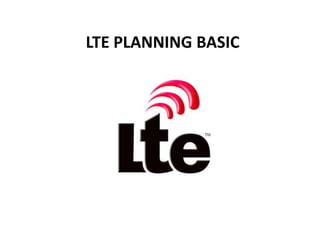
LTE Planning Basic
- 2. Introduction • In the context of mobile and cellular communication systems, RF Planning is the process of assigning frequencies, transmitter locations and parameters of a wireless communications system to provide sufficient coverage and capacity for the services required (e.g. mobile telephony). The RF plan of a cellular communication system revolves around two principal objectives; Coverage and Capacity Coverage relates to the geographical footprint within the system that has sufficient RF signal strength to provide for a call/data session. Capacity relates to the capability of the system to sustain a given number of subscribers. In 3GPP LTE systems, both capacity and coverage are interrelated. To improve quality some coverage, capacity has to be sacrificed, while to improve capacity, coverage will have to be sacrificed. The LTE RF planning process mainly consists four phases.
- 3. Phase 1: Initial RF Link Budget • The first level of the RF planning process is a budgetary level. It uses the RF link budget along with a statistical propagation model (e.g. Hata, COST-231 Hata or Erceg-Greenstein) to approximate the coverage area of the planned sites and to eventually determine how many sites are required for the particular RF communication system. The statistical propagation model does not include terrain effects and has a slope and intercept value for each type of environment (Rural, Urban, Suburban, etc.). This fairly simplistic approach allows for a quick analysis of the number of sites that may be required to cover a certain area. Following is a typical list of outputs produced at this stage: o Estimated Number of Sites
- 4. Phase 2: Detailed RF Propagation Modeling • The second level of the RF Planning process relies a more detailed propagation model. Automatic planning tools are often employed in this phase to perform detailed predictions. The propagation model takes into account the characteristics of the selected antenna, the terrain, and the land use and land clutter surrounding each site. Since these factors are considered, this propagation model provides a better estimate of the coverage of the sites than the initial statistical propagation model. Thus, its use, in conjunction with the RF link budget, produces a more accurate determination of the number of sites required. Following is a typical list of outputs produced at this stage:
- 5. Phase 2 • Number of Sites and Site Locations (and Height) • Antenna Directions and Down tilts • Neighbor Cell Lists for each site • Mobility (Handover and Cell Reselection) Parameters for each site. • Frequency Plan • Detailed Coverage Predictions (e.g. Signal Strength (RSRP), Signal Quality (RSRQ) Best CINR, Best Server Areas, Uplink and Downlink Throughput) • The following figure shows a typical coverage prediction out (All Sites coverage by Signal Strength).
- 6. Phase 3: Fine Tuning and Optimization • The third phase of the RF planning process incorporates further detail into the RF plan. This stage includes items such as collecting drive data to be used to tune or calibrate the propagation prediction model, predicting the available data throughput at each site, fine tuning of parameter settings (e.g. antenna orientation, down tilting, frequency plan). This process is required in the deployment of the system or in determining service contract based coverage. Following is a typical list of outputs produced at this stage: o A final List of Sites and Site Locations (and Height) o Optimized Antenna Directions and Down tilts o An optimized Neighbor Cell Lists for each site o Mobility (Handover and Cell Reselection) Parameters for each site. o An optimized Frequency Plan o Detailed Coverage Predictions (e.g. Signal Strength (RSRP), Signal Quality (RSRQ) Best CINR, Best Server Areas, Uplink and Downlink Throughput)
- 7. Phase 4: Continuous Optimization • The final phase of the RF planning process involves continuous optimization of the RF plan to accommodate for changes in the environment or additional service requirements (e.g. additional coverage or capacity). This phase starts from initial network deployment and involves collecting measurement data on a regular basis that could be via drive testing or centralized collection. The data is then used to plan new sites or to optimize the parameter settings (e.g. antenna orientation, down tilting, frequency plan) of existing sites.
